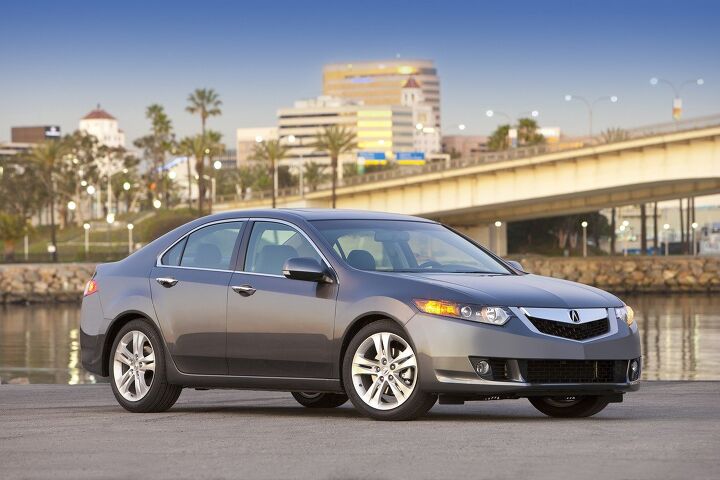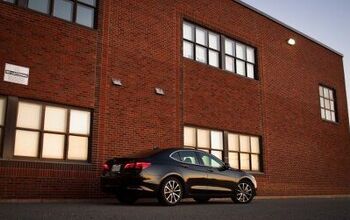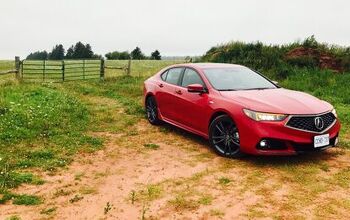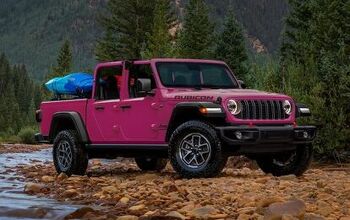Review: 2010 Acura TSX V6
Remember the ’86 Acura Legend Coupe, the definition of elegant muscle? Or how about the ’97 Integra Type R, the weekend racer you couldn’t break? These were Acuras that inspired passion, joy, and a special place burned into my long-term memory. Even though it’s been 24 and 12 years ago respectively since I drove these high points for Honda’s luxury brand, I remember them like it was yesterday. In contrast, I drove a TSX V6 a mere three days ago, and already my primary remaining impression of it is a longing for those Acuras of yesteryear. And my memory isn’t even that bad.
I’ve always liked Acuras. At least the idea of them. I don’t demand rear-wheel drive and V8s in my sport luxury cars. I appreciate the Honda work ethic, attention to detail and sense of assurance. The difficulty is, if you like them, you go to the dealership and wonder where they are. The TSX V6 is the perfect example. It’s a Honda Accord with a pretentious snout and three-times the buttons.
The interior is Steve Jobs personal Hell. Every necessary button comes with an average of four attendants. I stopped counting at five thousand.Things look very nice inside, in the current black and silver style, but nothing generates a ‘wow’. Nothing generates a ‘where’ or ‘what’ either, so I shouldn’t complain.
Ergonomically, everything is pretty much at or near where you’d guess it would be. Every switch and knob feels firm but pliable, like a good assistant or yoga trainer. Which is what luxury’s all about in the end.
Based on the European Honda Accord, the TSX exterior design is more crisp than its underlings. Cues like the hip crease are tense and sophisticated, but overall Acura’s design language has a limited vocabulary. There is not enough to give this car – the whole line, really – distinction. There is nothing terribly wrong with the TSX, it’s just not as attractive as, well, everything else in the class (the Lexus ES being the only possible exception.)
On that pretentious snout rests the Acura crest, a stylized caliper, signifying the company’s devotion to engineering. It is rightly placed over the hood. This is where the discipline shows. The V6 is new for 2010, offering the TSX’s first-ever step up from the four-cylinder. The 24-valve, single overhead cam with variable valve timing puts out 280 horses and 254 pound feet of torque. This is not insubstantial. The engine revs freely, effortlessly and on an easy to understand path. And there’s no shortage of grunt, despite the 3700 pounds.
The five-speed automatic transmission is equally attentive. As opposed to many competitors, this one is a worthy dance partner, never falling behind or stepping on the wrong cog. Downshifts were on time and correct, without the three-blind-mice effect, bumping around in search of the right gear. The automatic clipped to the four-cylinder actually achieves better gas mileage than the manual.
The V6 also comes with enhanced steering, which feels like they added a couple of clock weights to the standard electronic set up. The result is more satisfying than the over-juiced wheel in the base TSX. It is not better, just heavier. Heavier has a shorter learning curve which makes me wonder if I’d get used to the lighter settings, adapt my driving, and not care after a while.
One thing is certain: the brakes aren’t stopping potential buyers in their tracks. They are simply not as good as most of the competition. While not unsafe, they lack the precise feeling and sheer stopping power this drivetrain deserves.
The fact that the suspension is decent makes the inferior brakes even more disappointing. The car’s roll is minimal, keeping you fairly flat, without making your fillings fly out. The car is waggle free. Combined with the frictionless engine and alert tranny, the TSX is hardly short on fun.
But neither are the Audi A4, BMW 3, Mercedes C, Infinity G, Cadillac CTS, Hyundai Genesis, Volvo S80 . . . All of which have more personality in one department or another. The TSX is a conservative entry in a broad market segment. So while the car is not bad, it fails to stand out against a dozen direct competitors. And I’m probably forgetting some . . . Oh, right, the V6 Honda Accord, this car’s fraternal twin.
The suspension is assembled from the same components (albeit a tad softer.) The engine lacks a mere eight horsepower, though for that compromise your gas mileage climbs by two (city/highway average.) Though nearly identical in exterior measurements, the Accord offers six more cubic feet of cabin space. It might not be of the useful variety, but that’s not the point. It’s eight grand less (our tester stickered at $38,881) and, in many respects, it’s better.
The TSX’s luxury appointments are just that: appointments. The guts are too similar and style too tame. If you’re fond of Hondas and have more money than you used too, buy a V6 Accord, swap out the tires for a stickier set and donate the remaining six and a half Gs to your favorite charity. You’ll be better off, the world will be better off and maybe, in the long run, it’ll help make Acura better. Till then, thanks for the memories.
More by Michael Martineck
Latest Car Reviews
Read moreLatest Product Reviews
Read moreRecent Comments
- Jalop1991 In a manner similar to PHEV being the correct answer, I declare RPVs to be the correct answer here.We're doing it with certain aircraft; why not with cars on the ground, using hardware and tools like Telsa's "FSD" or GM's "SuperCruise" as the base?Take the local Uber driver out of the car, and put him in a professional centralized environment from where he drives me around. The system and the individual car can have awareness as well as gates, but he's responsible for the driving.Put the tech into my car, and let me buy it as needed. I need someone else to drive me home; hit the button and voila, I've hired a driver for the moment. I don't want to drive 11 hours to my vacation spot; hire the remote pilot for that. When I get there, I have my car and he's still at his normal location, piloting cars for other people.The system would allow for driver rest period, like what's required for truckers, so I might end up with multiple people driving me to the coast. I don't care. And they don't have to be physically with me, therefore they can be way cheaper.Charge taxi-type per-mile rates. For long drives, offer per-trip rates. Offer subscriptions, including miles/hours. Whatever.(And for grins, dress the remote pilots all as Johnnie.)Start this out with big rigs. Take the trucker away from the long haul driving, and let him be there for emergencies and the short haul parts of the trip.And in a manner similar to PHEVs being discredited, I fully expect to be razzed for this brilliant idea (not unlike how Alan Kay wasn't recognized until many many years later for his Dynabook vision).
- B-BodyBuick84 Not afraid of AV's as I highly doubt they will ever be %100 viable for our roads. Stop-and-go downtown city or rush hour highway traffic? I can see that, but otherwise there's simply too many variables. Bad weather conditions, faded road lines or markings, reflective surfaces with glare, etc. There's also the issue of cultural norms. About a decade ago there was actually an online test called 'The Morality Machine' one could do online where you were in control of an AV and choose what action to take when a crash was inevitable. I think something like 2.5 million people across the world participated? For example, do you hit and most likely kill the elderly couple strolling across the crosswalk or crash the vehicle into a cement barrier and almost certainly cause the death of the vehicle occupants? What if it's a parent and child? In N. America 98% of people choose to hit the elderly couple and save themselves while in Asia, the exact opposite happened where 98% choose to hit the parent and child. Why? Cultural differences. Asia puts a lot of emphasis on respecting their elderly while N. America has a culture of 'save/ protect the children'. Are these AV's going to respect that culture? Is a VW Jetta or Buick Envision AV going to have different programming depending on whether it's sold in Canada or Taiwan? how's that going to effect legislation and legal battles when a crash inevitibly does happen? These are the true barriers to mass AV adoption, and in the 10 years since that test came out, there has been zero answers or progress on this matter. So no, I'm not afraid of AV's simply because with the exception of a few specific situations, most avenues are going to prove to be a dead-end for automakers.
- Mike Bradley Autonomous cars were developed in Silicon Valley. For new products there, the standard business plan is to put a barely-functioning product on the market right away and wait for the early-adopter customers to find the flaws. That's exactly what's happened. Detroit's plan is pretty much the opposite, but Detroit isn't developing this product. That's why dealers, for instance, haven't been trained in the cars.
- Dartman https://apnews.com/article/artificial-intelligence-fighter-jets-air-force-6a1100c96a73ca9b7f41cbd6a2753fdaAutonomous/Ai is here now. The question is implementation and acceptance.
- FreedMike If Dodge were smart - and I don't think they are - they'd spend their money refreshing and reworking the Durango (which I think is entering model year 3,221), versus going down the same "stuff 'em full of motor and give 'em cool new paint options" path. That's the approach they used with the Charger and Challenger, and both those models are dead. The Durango is still a strong product in a strong market; why not keep it fresher?





































Comments
Join the conversation
.
"It was in the mid 90’s that Honda just went downhill on average (with Acura leading the charge)." "Although I’m not a fan of the Star Trek interior of the current Civic" Yes! Someone else noticed the subtle mid 90's change. It started really subtle... then eventually consumed the whole brand. Early 90's was just an awesome time, really. Honda at that time had very well made, simple, practical cars. Then everything got really haphazard and complicated in a stumbling move "upmarket." Which of course left them vulnerable to Hyundai / Kia. And you know what? People really like Star Trek. Whereas VW, BMW, Audi go for an artful, sophisticated (ok yeah Audi has been known to be over the top aggressive with their grilles) look Honda can and will GEEK their cars. Which is ironic that the GEEK squad drives VW and Chevrolet vans lol.